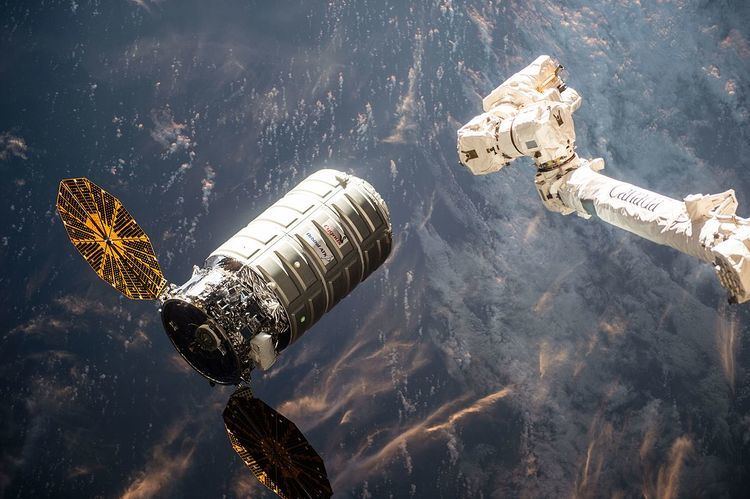Mission type ISS resupply Spacecraft type Enhanced Cygnus | Operator NASA Rocket Atlas V 401 | |
 | ||
Manufacturer Orbital Sciences
Thales Alenia Space Launch date March 23, 2016, 03:05:52 (2016-03-23UTC03:05:52) UTC | ||
Cygnus CRS OA-6, also known as Orbital Sciences CRS Flight 6, is the sixth flight of the Orbital ATK unmanned resupply spacecraft Cygnus and its fifth flight to the International Space Station under the Commercial Resupply Services contract with NASA.
Contents
The Cygnus spacecraft for this mission is named the S.S. Rick Husband in honor of astronaut Rick Husband.
History
The first COTS demonstration mission with a Cygnus concluded successfully in September 2013 and Orbital commenced operational ISS cargo missions under the Commercial Resupply Service (CRS) program with two missions in 2014. However, the third operational mission, Orb CRS-3, was unsuccessful due to catastrophic failure of its Antares 130 launch vehicle. Orbital discontinued the Antares 100 series in favor of the planned Antares 200, upgraded with newly built RD-181 first stage engines to provide greater payload performance and increased reliability.
While the Antares 200 was under development in 2015–2016, the company contracted with United Launch Alliance for the Atlas V launch of CRS OA-4, which occurred on 6 December 2015, to be followed by the Atlas V launch of CRS OA-6 on 23 March 2016.
Orbital ATK plans subsequent launches of CRS OA-5 in Q3 2016 and CRS OA-7 in Q4 2016 on the new Antares 230. Together with CRS OA-6, these missions will enable Orbital ATK to cover their initial CRS contracted payload obligation.
Production and integration of Cygnus spacecraft is performed in Dulles, Virginia. The Cygnus service module is mated with the pressurized cargo module at the launch site, and mission operations are conducted from control centers in Dulles and Houston.
Launch
On 23 March 2016 (UTC), Cygnus CRS OA-6 was successfully launched by the Atlas V into Low Earth orbit. During the flight, the rocket had a first-stage anomaly that led to shutdown of the first-stage engine approximately five seconds before anticipated. The anomaly forced the Centaur upper stage of the rocket to fire for approximately one minute longer than planned, using reserved fuel margin, but did not significantly impact payload orbital insertion. The preplanned deorbit burn successfully deorbited the stage, but not precisely within the designated location. The issue marked the first Atlas V anomaly in over eight years to be publicly acknowledged by ULA.
Spacecraft
OA-6 is the fifth of ten flights by Orbital ATK under the Commercial Resupply Services contract with NASA. This will be the second flight of the Enhanced sized Cygnus PCM. The delay of the NOAA GOES-R satellite from March 2016 to October 2016 created this Atlas V launch opportunity for CRS OA-6 to be launched before OA-5. The mission was launched on March 23, 2016.
In keeping with an Orbital Sciences tradition, this Cygnus spacecraft is named the S.S. Rick Husband after the NASA astronaut who commanded the Space Shuttle Columbia's fatal STS-107 mission in 2003.
Manifest
Total weight of cargo: 3,513 kg (7,745 lb) using Enhanced Cygnus.
Saffire-1
Saffire-1 is a NASA test to study flammability and fire propagation in space, using the CRS OA-6 after it has delivered cargo to the International Space Station. The spacecraft is fitted with various sensors and cameras to record data during what is expected to be a 20-minute fire, to determine how much fire resistance is needed in the ultra-light material used in the spacecraft and astronaut's gear. OA-6 will later disintegrate as it enters the Earth's atmosphere.
Other ORB projects
After this OA-6 flight, NASA plans to launch two more Cygnus cargo missions in 2016: OA-5 on July 6 and OA-7 on December 30. They will be followed by three flights from the extended contract: OA-8E on June 12, 2017, OA-9E later in 2017 and OA-10E in 2018. The schedules in early 2017 are dynamic, due to the first manned commercial flights (SpaceX, Boeing) to ISS.
